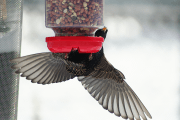European Starling (sturnus vulgaris)
Starling Control & Products
Effective control strategies for Starlings as follows:
Netting:– The most effective product for the 100% Exclusion of Starlings in all situations. The HDPE Bird Netting is a versatile barrier that denies birds the ability to access literally any architectural configuration and is typically used in applications where maintaining building aesthetics is critical.
The Bird Netting is made from High Density Polyethylene; Polyethylene is the most ultra- violet (U.V) resistant netting material available and has extra U.V. stabilizers added in its raw materials and will not rot or absorb water.
Specific flame-proof netting is also available which contains fire retardant properties that have fine filaments that melt and drop away before propagating a flame. So when the netting is exposed to an open flame the netting literally disappears.
Where required the installation of Heavy Duty Nylon Zippers will be installed to provide access to services incl. Lights, sprinkler valves, smoke detectors, etc.
At ELITE Bird Control we insist on only using quality materials and fixings and we can create innovative designs that are virtually invisible. It is a humane bird control system and will permanently solve your bird infestation problems.
Bird Shock Track:– This system is ideal in most situations because the system provides an intermittent shock that simply teaches the Starlings to stay away, long term. The electric bird deterrent system is changing the face of the bird control industry – building owners are actually paying to have spikes replaced with this electric deterrent system. The Shock-Track is a low-profiled electrical deterrent system which is flexible and adaptable and can conform to any architectural configuration. Once installed the track is very hard to see close up and virtually invisible from a distance.
Bird Slope:– A brilliant proofing system that will keep Starlings of ledges permantely.
Bird Spikes:– The use of Bird Spikes consisting of UV-stabilised bases with stainless steel wires are perfect for Starlings in an environment, where the Starlings’ impact pressure is light to medium.
Post & Wire:– Will stop Starlings from perching on a variety of ledges, guttering and piping.
Mist Netting/Live Bird Capture:– This innovative strategy that can be implemented to catch and remove Starlings. It can be used inside any food manufacturing, preparation, warehousing environments, shopping centres and anywhere the use of poisons (Avicides) is not an option.
Trapping – This method can be a very effective strategy in certain situations where there is a heavy Starling infestation.
Avicides – Only to be carried out by licensed technicians and limited to be carried out in precise situations and environments for the control of Starlings.
Bristle Strips and Anti Bird Mesh Systems:– A proofing solution to exclude Starlings from seeking out their favourite harbourages where it is not practicable to install any other deterrent product.
The European or Common Starling:- has been labelled as one of the world’s 100 most invasive species. Starlings have been established in eastern Australia since the late 1800′s with detrimental impacts on the native bird populations. They are comfortable nesting in roof and ceiling cavities and can cause significant damage and create a significant mess and health issue when nesting in confined roof and cavity spaces.
IDENTIFICATION:- Starlings are a small bird between 20 and 22cm in length with metallic green, black and purple feathers. Prior to the breeding season they have a black beak and white tipped feathers which give them a speckled appearance. During breeding they lose their speckle sand, their beak becomes yellow in colour.
BIOLOGY & BREEDING:-Starlings are native to Europe, Asia and North Africa, but have been introduced to many other parts of the world. The starling breeding season occurs mainly in spring and summer, from September to December, but can be anywhere between July and March. Most species nest in holes, laying between 4 and 8 blue or white eggs and can raise up to three broods per season.
HABITS & DAMAGE: Starlings are highly adaptable birds that can live in different habitats and feed on many food sources such as grains, fruit and garbage. Starlings aggressively take over and defend hollows suitable for nesting. Less aggressive birds with similar nesting habits and nest size are at greatest risk of displacement.
The European or Common Starling,
The Common Starling has been labelled as one of the world’s 100 most invasive species. Starlings have been established in eastern Australia since the late 1800′s with detrimental impacts on the native bird populations. They are comfortable nesting in roof and ceiling cavities and can cause significant damage and create a significant mess and health issue when nesting in confined roof and cavity spaces.
IDENTIFICATION:- Starlings are a small bird between 20 and 22cm in length with metallic green, black and purple feathers. Prior to the breeding season they have a black beak and white tipped feathers which give them a speckled appearance. During breeding they lose their speckle sand, their beak becomes yellow in colour.
BIOLOGY & BREEDING:- Starlings are native to Europe, Asia and North Africa, but have been introduced to many other parts of the world. The starling breeding season occurs mainly in spring and summer, from September to December, but can be anywhere between July and March. Most species nest in holes, laying between 4 and 8 blue or white eggs and can raise up to three broods per season.
HABITS & DAMAGE:- Starlings are highly adaptable birds that can live in different habitats and feed on many food sources such as grains, fruit and garbage. Starlings aggressively take over and defend hollows suitable for nesting. Less aggressive birds with similar nesting habits and nest size are at greatest risk of displacement.



